Viewpoint: Why are so few WW1 heroines remembered?
- Published
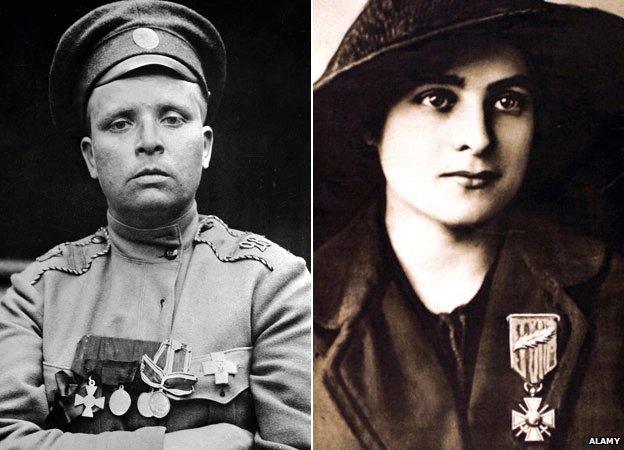
She-soldiers fought alongside men and challenged social expectations
World War One had many heroines, including 'she-soldiers', spies and martyrs. Their heroism was praised during the war but they were not always remembered in a positive light afterwards, says Prof Alison Fell.
World War One created new kinds of heroes and heroines. The main route to heroism for men was through the bearing of arms. Following the mass mobilisation of civilians into the armed forces, military heroism became more democratised, as any man donning a uniform could potentially be seen as a hero.
Medics, skilled male auxiliaries and members of the labour corps were sometimes seen as heroic, but it was front-line soldiers who were placed at the top of the hierarchy of male heroism.
The shift in the ways that heroism was understood, and the advent of "total war" in which a large percentage of the population were actively engaged in the war effort, meant that women could be seen as heroic, too.

Changing Faces of Heroism
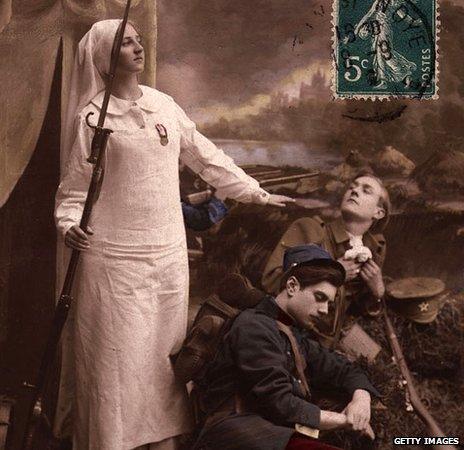
WW1 moved away from traditional views of heroism and created new kinds of heroes and heroines. Prof Alison Fell explores how and why views changed in a free online course (MOOC) from the BBC and the University of Leeds.

Their heroism was sometimes related to the ways they carried out their pre-war roles in exceptionally difficult circumstances - nurses caring for the wounded on trains, ships and hospitals, or bereaved mothers and wives stoically coping with their losses, workers taking on jobs normally reserved for men, and housewives coping with the privations of war. They were all perceived, in different ways, to demonstrate heroic qualities of bravery, endurance and selflessness.
But other women, especially those close to the front lines, took on roles that challenged social expectations about the roles and duties of men and women. Some took up arms, becoming 'she-soldiers'. The name was given in previous centuries to women who dressed up as men in military uniforms and who were popular characters in ballads and folk-tales.

The best-known British 'she-soldier' is Flora Sandes
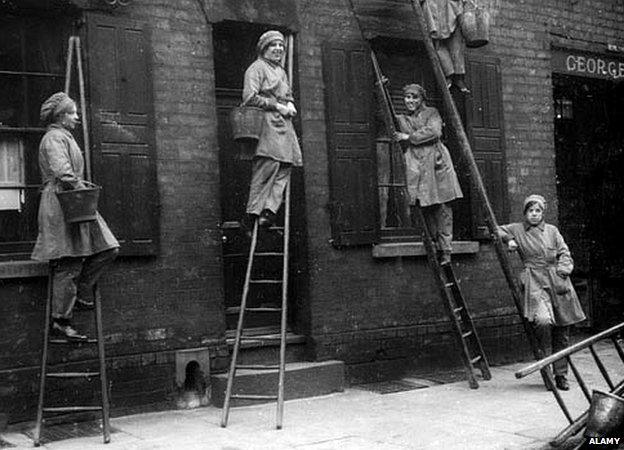
Women at home who took on jobs normally reserved for men were often hailed as heroines
During WW1 some female fighters were claimed as war heroines and were photographed and praised in newspapers, but their heroism was not always remembered in such a positive light once the guns had fallen silent.
When war broke out, these women were keen to prove their worth and join the Armed Services. In Britain, members of the Women's Volunteer Reserve, founded in 1914 by wealthy suffragette Evelina Haverfield, adopted army ranks, dressed in khaki and practised their drills in central London - to the scorn of some journalists.
In France, cross-dressing archaeologist and journalist Jane Dieulafoy, who had already had experience of being at the front in the Franco-Prussian war, petitioned the government to create a women's auxiliary corps. Only in Britain, however, in the manpower crisis of 1917, were such corps founded, and then only to perform non-combatant roles such as domestic and clerical work.
Other fronts saw women get more involved. On the Western Front, individual women were caught up in the action. Emilienne Moreau was a 17-year-old who killed German soldiers while helping British members of the 9th Black Watch during the Battle of Loos. She was awarded medals and nicknamed the "Heroine of Loos" in both the French and British press.

Woman's work?
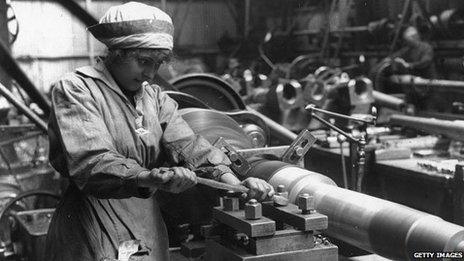

Later in the war, resistance networks in occupied France and Belgium sought to undermine and disobey the martial laws of the German occupiers. As was to be the case in the World War Two, occupation blurred the line between combatant and non-combatant and resistance networks involved both sexes.
Women carried out tasks such as train-watching, publishing and distributing underground newspapers and smuggling Allied soldiers back to their lines. Edith Cavell, the most famous female member of these resistance networks, helped some 200 French and British soldiers to escape. She was found guilty along with other members of her network of treason and executed by firing squad in September 1915.
Other women worked as spies for the newly formed British and French secret services. Frenchwoman Louise de Bettignies worked as an agent for the British and ran an intelligence network in Lille. After she was arrested and found guilty her death sentence was commuted to life imprisonment, but she died in a German prison in September 1918.
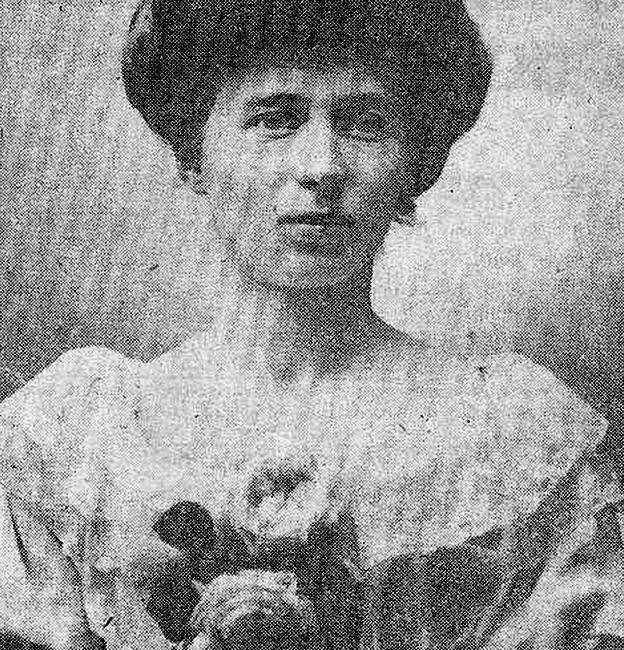
Spy Louise de Bettignies used the pseudonym of Alice Dubois
Unsurprisingly, the Germans objected strongly to the creation of "resistance heroines" during the war. Teenage fighter Moreau was attacked as a "franc-tireur" or "free shooter", as a civilian taking up arms. Just as Allied propaganda headlines condemned Germans for "murdering" Edith Cavell, so the German press condemned Moreau for "murdering" German soldiers and violating the 1906 Geneva convention.
The only officially sanctioned group of "she-soldiers" in the war were the members of the Russian Battalion of Death, led by Maria Bochkareva. She had initially been granted special permission to enlist in the Imperial Russian Army by Tsar Nicholas II. Upon his abdication she was asked to create a female battalion by the minister of war. But they were not considered as an alternative to male soldiers. Part of the attraction of deploying women in Russia's army was their propaganda value as a recruitment tool to "shame" men into enlisting.
There were other women who took up arms. The best-known British she-soldier is Flora Sandes, who changed her uniform as a member of the First Aid Nursing Yeomanry Corps for that of a captain in the Serbian Army. French athlete, pilot and journalist Marie Marvingt served for three weeks by disguising herself as a French soldier. British journalist Dorothy Lawrence also disguised herself and served for 10 days.
So how were these heroines remembered after the war? Women who had taken on men's roles during the war were subject to suspicion and sometimes to ridicule in peacetime.
Sandes expressed disappointment and dissatisfaction with life in Britain after the war and eventually settled with her husband, a former Russian general, in Serbia. Marie Marvingt attempted to use her skills as a pilot in the interwar period in France but was unable to persuade the French army to employ her in an official capacity.
Lawrence's attempt to find commercial success as a journalist on the strength of her war experiences failed, she eventually died in an asylum in 1925. In Bochkareva's case, her heroism did not protect her for long in the new Russia. Tainted by her connection with the White Army, she was executed by the Bolsheviks in 1920.

What are MOOCS?

MOOCs stands for massive open online courses and are a new way of learning from the world's leading academics. The BBC is launching four WW1 MOOCs, working with leading universities.
Explore the courses by registering here.

Rather than the handful of exceptional women who took up combatant roles, it was the heroines whose role did not contradict or challenge traditional views of femininity who came to dominate memories of the war.
Pride of place was given to nurses. During the war, they had worked close to the front lines undoubtedly displayed heroic qualities. They had braved shells and infectious diseases to care for the sick and wounded. But importantly, their association with a traditional feminine maternal and nurturing role did not jar in a post-war world eager for a return to the status quo. Women were called upon to repopulate the nation through their roles as mothers and to accept a secondary status in favour of returning men in the workplace.
The "resistance heroines" who had died, most famously Cavell, could forever remain heroine-martyrs, eternally fixed in this role in monuments that elevated them above the crowd. But those who survived could dress and act as men in a moment of national or international crisis, but the exceptional acts that had marked them as heroic in wartime were often met with embarrassment or silence in peacetime.
Find out more about MOOCs and register here. Also, discover more about the World War One Centenary.
You can follow the Magazine on Twitter, external and on Facebook